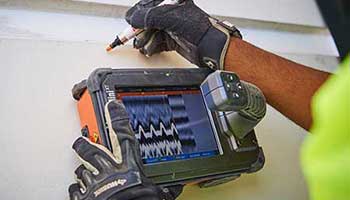
Many different professions rely on GPR for concrete scanning in order to conduct their work more safely and efficiently. Since the mid-1980’s, ground penetrating radar has made it widely possible to locate utilities, measure the depth of a concrete slab, or “see” what lies inside a concrete wall. Today, instead of going in blindly with a jack hammer or picking up a drill and making an educated guess, architects, builders, plumbers, and electricians can perform their work with confidence that they won’t put employees at an unnecessary risk or destroy something beneath the surface, causing expensive delays. Concrete scanning before drilling, coring, or cutting saves time, money, and heart-ache.
 The goal of GPR is to give the client a good working knowledge of something that can’t be seen. The customer may be aware that utility pipes, conduits, tension cable, or reinforcing rebar are there somewhere, but knowing precisely where they are prevents nasty, costly surprises on the jobsite. Concrete scanning can also locate areas of weakness below ground that might cause cave-ins, such as cracks or voids beneath a concrete slab.
The goal of GPR is to give the client a good working knowledge of something that can’t be seen. The customer may be aware that utility pipes, conduits, tension cable, or reinforcing rebar are there somewhere, but knowing precisely where they are prevents nasty, costly surprises on the jobsite. Concrete scanning can also locate areas of weakness below ground that might cause cave-ins, such as cracks or voids beneath a concrete slab.
Concrete scanning uses electromagnetic energy and is a safe, non-destructive means of avoiding potential damage. As the GPR equipment rolls over the survey site, it sends electromagnetic pulses into the concrete. The two-way travel time of the waves reflected off subsurface objects makes it possible to calculate the depth and location of pipes, wires, rebar, and other buried material. The customer will receive a report showing the location and depth of underlying obstructions so that construction may safely begin.
Whether you need to “see” beneath a concrete slab or inside a wall, GPR makes it possible. It is simply the best tool for making sure you understand the subsurface so that your work can proceeds safely and on schedule, with no buried surprises.
